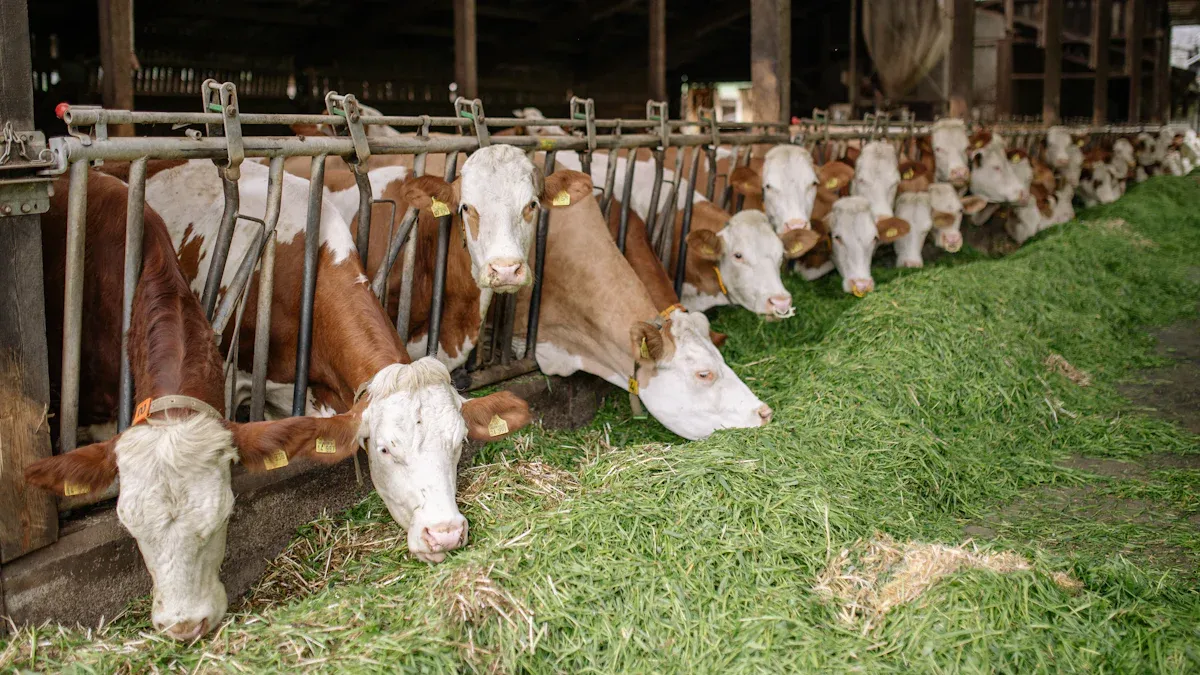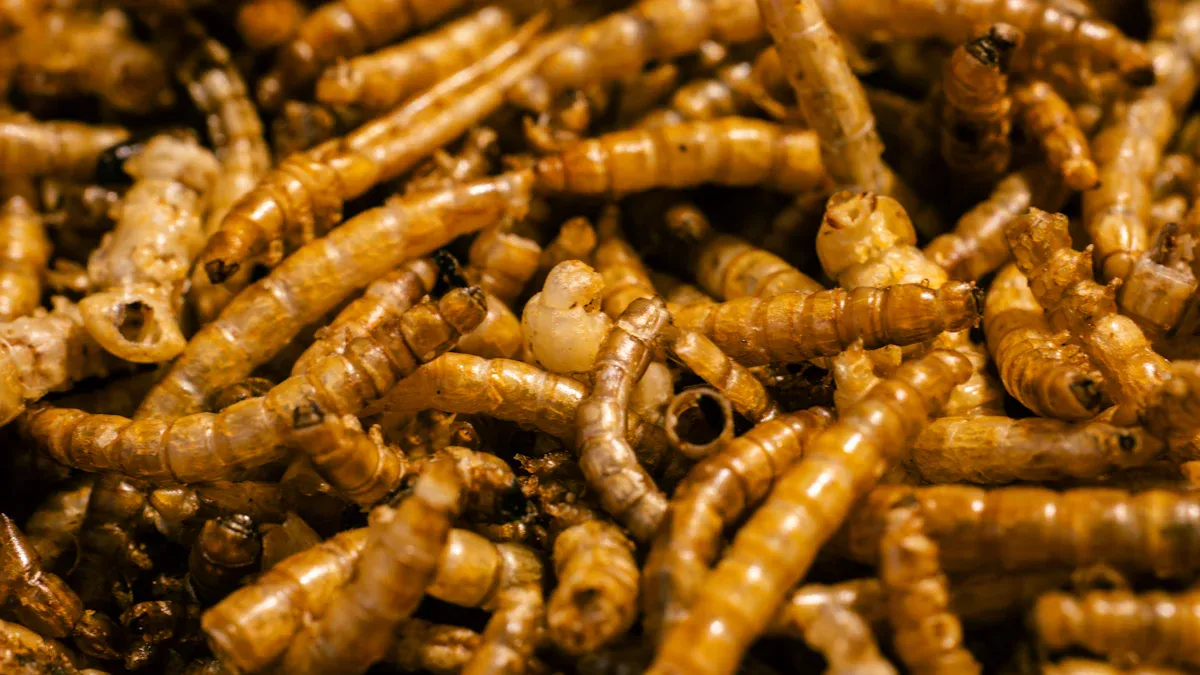
Dried yellow mealworm protein is revolutionizing farming in Oceania. Farmers are turning to this eco-friendly option for its sustainability and rich nutrients. As a leading mealworm supplier, we ensure that about half of the dried yellow mealworm feed comes from biowaste, reducing waste and boosting efficiency. Plus, mealworms fed with potato cuttings double their fat content, offering a nutrient-packed solution for greener farming.
Key Takeaways
- Dried yellow mealworms are a green protein source. They grow on waste, helping cut trash and pollution.
- Mealworm frass is a natural fertilizer. It boosts soil health and helps farming without harmful chemicals.
- Farmers can use mealworms to feed animals and fish. They are rich in protein and lower the need for regular feeds.
Benefits of Dried Yellow Mealworm in Agriculture

Nutritional Advantages for Farming
Dried yellow mealworm offers a powerhouse of nutrients that benefit farming. Its protein content is exceptionally high, making it a valuable feed option for livestock and aquaculture. Studies show that mealworms fed with fermented chicory roots significantly increase essential minerals like calcium, iron, and manganese. Here’s a quick look at how different feed sources impact mealworm nutrition:
| Feed Source | Mineral Content Effect |
|---|---|
| Fermented chicory roots | Significant increase in Ca, Fe, and Mn |
| Vegetable mix and horticultural foliage | No significant effect on mineral content |
| Fermented straw | Improved nutrient uptake observed |
Farmers can use this nutrient-rich protein to enhance animal health and productivity. It’s a sustainable way to meet the growing demand for high-quality feed.
Comparison to Traditional Protein Sources
Compared to traditional protein sources like corn or soy, dried yellow mealworm stands out. A study in South Africa revealed that many small-scale poultry farmers were unaware of mealworms as a feed option. However, over two-thirds of them expressed interest in adopting it due to its superior protein content. Unlike corn, which requires extensive land and water, mealworms thrive on biowaste, making them a more sustainable choice.
Farmers also benefit from the versatility of mealworms. They can be used in various farming systems, from poultry to aquaculture, without the environmental strain caused by conventional feeds.
Functional Benefits for Soil and Crops
Dried yellow mealworm farming doesn’t just support livestock; it also improves soil health. Research shows that mealworm frass (insect waste) enhances soil fertility by increasing nitrogen, phosphorus, potassium, and organic carbon levels. These nutrients are vital for healthy crop growth.
Although some studies noted that these improvements didn’t always boost forage yield due to agronomic challenges, the potential for long-term soil health remains promising. By integrating mealworm frass into farming practices, farmers can reduce reliance on synthetic fertilizers and promote organic farming methods.
Environmental Impact of Dried Yellow Mealworm
Lower Carbon Emissions in Production
Producing dried yellow mealworm generates significantly fewer carbon emissions compared to traditional livestock farming. Studies show that mealworms thrive on agricultural sidestreams, such as biowaste, which reduces the need for resource-intensive feed. This sustainable approach not only cuts down on greenhouse gas emissions but also minimizes the overall environmental footprint of farming. By choosing mealworms over conventional protein sources, farmers can contribute to a cleaner, greener planet.
Minimal Land and Water Usage
Mealworm farming requires far less land and water than raising cattle, pigs, or chickens. For instance, a small indoor space can house thousands of mealworms, making it an efficient option for urban and rural farmers alike. Unlike livestock, mealworms don’t need large grazing areas or constant water supplies. This makes them an ideal solution for regions in Oceania where water scarcity and land availability are ongoing challenges.
Did you know? Producing one kilogram of mealworm protein uses up to 90% less water than producing the same amount of beef protein. That’s a game-changer for sustainable agriculture!
Waste Valorization Through Mealworm Farming
Mealworm farming turns waste into value. These insects can consume organic waste like potato peels, vegetable scraps, and fermented straw, converting it into high-quality protein and nutrient-rich frass. This process not only reduces food waste but also creates a circular farming system where nothing goes to waste. Research highlights how mealworm farming can address global protein demands while promoting sustainability. By adopting this practice, farmers can reduce their reliance on traditional feed and fertilizers, paving the way for a more eco-friendly future.
Applications in Oceania’s Agriculture
Sustainable Livestock Feed
Farmers in Oceania are exploring dried yellow mealworm as a sustainable alternative to traditional livestock feed. This protein-rich option offers a practical solution to reduce reliance on soya bean and fishmeal. Small-scale farmers in South Africa have shown interest in adopting mealworms for poultry feed. Many believe this shift could lower costs and increase income.
Studies reveal that over two-thirds of small-scale poultry farmers are willing to try mealworms, even if they are unfamiliar with them. Farmers with secondary education are more likely to adopt this feed, but awareness campaigns can help older farmers understand its benefits. By using mealworms, farmers can improve livestock health while reducing environmental impact.
Organic Fertilizer Production
Mealworm farming doesn’t just provide feed; it also creates organic fertilizer. Mealworm frass, or insect waste, is packed with nutrients like nitrogen, phosphorus, and potassium. These elements are essential for healthy soil and crops. Farmers can use this natural fertilizer to replace synthetic options, promoting organic farming practices.
In Oceania, where soil health is a growing concern, mealworm frass offers a sustainable solution. It enriches the soil and supports long-term agricultural productivity. By integrating this fertilizer into their practices, farmers can reduce chemical use and improve crop yields.
Role in Aquaculture Practices
Aquaculture in Oceania benefits greatly from dried yellow mealworm protein. Its high protein content, ranging from 40.7% to 52.3%, makes it an excellent feed for fish and other aquatic species. Mealworms also contain oleic acid, palmitic acid, and linoleic acid, which enhance the nutritional profile of aquaculture feed.
| Nutritional Component | Value (%) | Notes |
|---|---|---|
| Protein Content | 40.7–52.3 | High protein-rich biomass suitable for feed |
| Oleic Acid | 30–60 | Most abundant fatty acid in mealworm larvae |
| Palmitic Acid | N/A | Present in mealworm larvae |
| Linoleic Acid | N/A | Present in mealworm larvae |
Farmers can use mealworms to improve fish growth and health while reducing the environmental strain of traditional fishmeal. This sustainable approach supports Oceania’s growing aquaculture industry and helps meet global seafood demand.
Dried yellow mealworm protein is reshaping agriculture in Oceania. Its versatility and sustainability make it a game-changer for greener farming. Farmers benefit from its rich nutritional profile, while the environment gains from reduced waste and lower emissions.
Key Highlights:
-
Nutritional Profile:
Aspect Findings Fatty Acid Profile Mealworms fed with potato cuttings showed enhanced fat content. Mineral Content Fermented chicory roots boosted essential minerals like calcium and iron. -
Sustainability:
- Upcycles biowaste into valuable protein.
- Reduces reliance on traditional feeds like soya and fishmeal.
By embracing this innovative protein source, Oceania can lead the way in sustainable agriculture and food security. 🌱
FAQ
What makes dried yellow mealworms a sustainable protein source?
Mealworms thrive on biowaste, require minimal land and water, and produce fewer emissions than traditional livestock. This makes them an eco-friendly choice for farming. 🌱
Can mealworms replace traditional livestock feed entirely?
Yes, mealworms can replace traditional feeds like soy or fishmeal. Their high protein content and nutrient profile make them a versatile and sustainable alternative.
Is mealworm farming suitable for small-scale farmers?
Absolutely! Mealworm farming requires little space and resources. It’s an excellent option for small-scale farmers looking to adopt sustainable practices and reduce costs.


